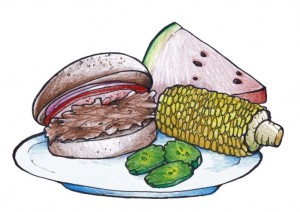I have fond childhood memories of spending a week or two every summer with my grandparents at their home in the country. Their vegetable garden was probably as large as my current back yard. Although they raised meat and it was usually on the menu, the simple summer suppers I remember most clearly only included produce from the garden. In August the dinner plate might look like this: thick slices of juicy, red tomatoes topped with our choice of salad dressing; fried baby potatoes; and corn on the cob. My grandpa would have harvested the corn less than an hour before we ate. Dinner was often followed by a bowl of vanilla ice cream with fresh fruit on top.
Who knew some of my grandparent’s eating habits would top the current food trends? Last year, the Midwestern Food Movement made the National Restaurant Association list and this year composting and “hyper-local” were listed as trends to watch. It doesn’t get more local than the backyard garden! So, what exactly is “local” food?
There is no one definition for “local” when referring to food. Depending on the audience and purpose “local” can be described in many ways. Sometimes it’s by geographic area, such as “Midwest” or state or county lines. Other times, mile radius is used to describe the distance between where the food was grown or produced and where it is being eaten. Common examples are 50 miles or 100 miles. Other times, the supply chain might indicate “local” means food purchased directly from growers and producers at farmers’ markets, auctions, farm stands or Community Supported Agriculture (CSAs). Local food does not have one definition. But local food does offer an opportunity to assess our own values, resources and choices about food and to determine what “local food” means to us.
In addition to purchasing directly from the grower or producer, local foods are available for purchase at businesses like grocery stores and restaurants . In addition to these locations, print and online directories offer additional resources promoting local food from national, regional, state, county and community sources. Here is a link to a summary of online directories to find food in Ohio.
 Like my example of “hyper-local” at my grandparent’s house, you probably already eat local foods, whether it is fresh herbs from a container garden, a local dairy that sells ice cream or fish from a favorite river or lake. In partnership with the Northwest Ohio Food Council, infinitely Green Consulting and local artist Alyssa Caris, Ohio State University Extension created examples of what local Ohio local food menus (PDF)might look like for both different meals of the day and different seasons of the year. For example, this drawing shows a late summer meal containing a pulled pork sandwich topped with homegrown sliced tomatoes and onions, and a side of home-canned pickles. The pork is flavored with a locally made barbeque sauce. Add fresh watermelon and corn on the cob.
Like my example of “hyper-local” at my grandparent’s house, you probably already eat local foods, whether it is fresh herbs from a container garden, a local dairy that sells ice cream or fish from a favorite river or lake. In partnership with the Northwest Ohio Food Council, infinitely Green Consulting and local artist Alyssa Caris, Ohio State University Extension created examples of what local Ohio local food menus (PDF)might look like for both different meals of the day and different seasons of the year. For example, this drawing shows a late summer meal containing a pulled pork sandwich topped with homegrown sliced tomatoes and onions, and a side of home-canned pickles. The pork is flavored with a locally made barbeque sauce. Add fresh watermelon and corn on the cob.
Please celebrate Ohio Local Foods Week, August 9-15th, 2015. While we encourage you to enjoy local foods throughout the year, the Ohio State University Extension Local Foods Signature Program team invites you to use this week in August to look for specific events and to participate in the $10 Ohio Local Foods Challenge, asking you to spend at least $10 on locally produced foods. Why commit to spending at least $10 on local foods during this week? You will not only enjoy the tastes of local foods, but it will also provide a way to become better informed about the nutritional, economic, and social benefits of foods across our agricultural state. To share your commitment, please sign up here for the $10 Ohio Local Foods Challenge.

